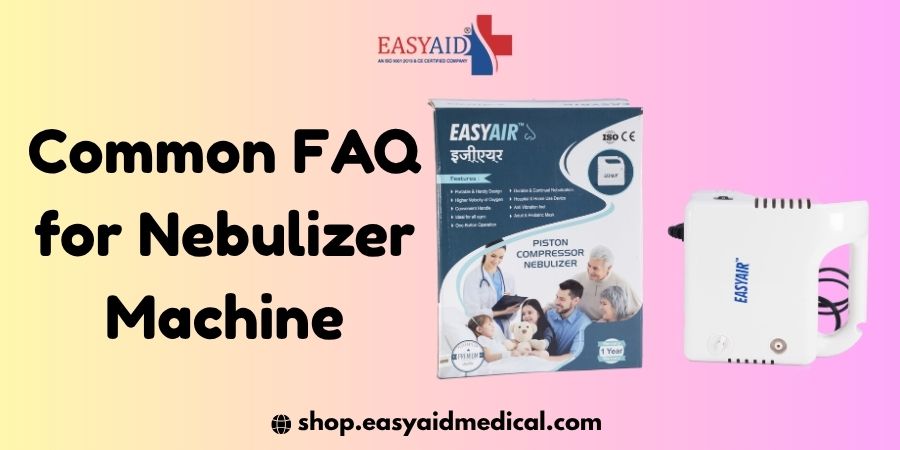A Nebulizer Machine is a compact medical device that turns liquid medication into a fine mist, making it easier to inhale the medicine directly into the lungs. It’s widely used for people suffering from asthma, COPD, bronchitis, and other respiratory conditions.
This guide answers the most frequently asked questions from patients, caregivers, and healthcare professionals about nebulizer machines.
1. What is a Nebulizer Machine?
A nebulizer is an electric or battery-operated device that converts prescribed liquid medicines into aerosol mist. The user inhales the mist through a mouthpiece or face mask, allowing the medicine to reach deep into the lungs for quick relief.
2. Who needs to use a nebulizer?
Nebulizers are prescribed for:
- Asthma and chronic obstructive pulmonary disease (COPD)
- Bronchitis and chronic cough
- Allergic respiratory conditions
- Children or elderly who have difficulty using inhalers
- Post-surgery patients with breathing difficulties
Doctors may recommend nebulizers when inhalers aren’t sufficient or easy to use.
Also Read
3. How does a nebulizer work?
The nebulizer uses compressed air or ultrasonic vibrations to convert liquid medication into mist.
- The medicine cup holds the prescribed liquid drug.
- The compressor or ultrasonic unit produces airflow or vibrations.
- This converts the liquid into aerosol.
- The user inhales the mist through a mask or mouthpiece until the cup is empty.
4. What types of nebulizers are available?
There are three main types:
- Jet Nebulizer: Uses compressed air to form mist (most common and affordable).
- Ultrasonic Nebulizer: Uses sound waves; quieter and faster.
- Mesh Nebulizer: Uses a vibrating mesh to create fine mist; portable and efficient.
5. What medications are used in a nebulizer?
Common medicines include:
- Bronchodilators (e.g., Salbutamol, Levosalbutamol)
- Steroids (e.g., Budesonide)
- Saline solutions for moisture and mucus clearance
- Antibiotics (if prescribed)
6. Is a nebulizer better than an inhaler?
Both deliver medicine directly to the lungs, but they differ in use:
- Inhalers are portable but need coordination and proper technique.
- Nebulizers are easier for children, seniors, and patients with severe breathing issues.
Doctors may recommend one or both depending on your condition.
7. How do I use a nebulizer correctly?
Follow these steps for proper use:
- Wash your hands thoroughly.
- Assemble the nebulizer and connect the air tubing.
- Add the prescribed dose of medication into the medicine cup.
- Attach the mask or mouthpiece.
- Turn on the device and breathe normally through the mouth until the mist stops.
- Wash and dry all removable parts after each use.
8. How often should I use a nebulizer?
Usage depends on your doctor’s prescription — typically 2 to 4 times a day.
Do not use it more frequently without consulting your physician, as overuse may cause side effects or irritation.
9. How long does one nebulization session take?
A typical session lasts 5 to 15 minutes, depending on the medication quantity and device type.
10. Can children and babies use a nebulizer?
Yes. Pediatric nebulizers are available with smaller masks designed for children and infants. They’re highly effective for asthma, cough, or respiratory infections in young patients.
11. Are there any side effects of using a nebulizer?
Possible side effects (depending on medication) include:
- Dry mouth or throat irritation
- Tremors or fast heartbeat (with bronchodilators)
- Coughing or mild dizziness
If you experience chest pain, rash, or severe breathing issues, stop use and contact your doctor immediately.
12. How do I clean and maintain a nebulizer?
Proper cleaning prevents infection:
- After every use, detach the mouthpiece/mask and cup.
- Wash them with warm water and mild soap.
- Air-dry on a clean towel.
- Once a week, disinfect by soaking in vinegar-water solution (1 part vinegar to 3 parts water) for 30 minutes.
- Replace filters and tubing as recommended by the manufacturer.
13. Can I travel with a nebulizer?
Yes. Portable nebulizers (battery or USB powered) are ideal for travel. Keep medicines, charger, and spare batteries handy. Always carry a doctor’s prescription when flying internationally.
14. How long does a nebulizer last?
With proper care, a nebulizer machine can last 3–5 years.
Replace masks and tubing every 3–6 months for hygiene and performance.
15. How do I know when my nebulizer isn’t working properly?
Check for:
- Weak mist output
- Unusual noise
- Leaking medication cup
- Cracked tubing or mask
If the mist becomes irregular or the device overheats, clean it and contact the manufacturer or your healthcare provider.
16. Is it safe to share a nebulizer?
No. Even when disinfected, sharing a nebulizer can spread bacteria and viruses. Each patient should have a personal nebulizer kit.
17. Can I use saline only in a nebulizer?
Yes. Normal saline (0.9% sodium chloride) is often used alone to relieve dryness, loosen mucus, and soothe airways. However, it should be sterile and used under medical guidance.
18. What are the popular nebulizer brands in India?
Trusted and widely used brands include:
- Omron Nebulizer
- Dr. Morepen Nebulizer
- Philips Respironics
- Beurer Nebulizer
- EasyAir Nebulizer
- Rossmax Nebulizer
19. How much does a nebulizer cost in India?
- Home-use models: ₹1,200 – ₹2,500
- Portable or mesh nebulizers: ₹3,000 – ₹6,000
- Hospital-grade units: ₹8,000 and above
20. Can I use tap water in my nebulizer?
No. Always use distilled or sterile water for cleaning or saline preparation. Tap water may contain minerals or bacteria that can damage the device or cause infection.

